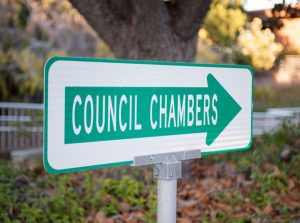Online Exclusive March 6, 2018
A City Hall-led effort to change Santa Clara’s practice of electing the City Clerk looks like a non-starter with voters.
Almost half of the 33 registered* resident responders (15) to last month’s Peak Democracy Open City Hall survey opposed changing the current system of electing the City Clerk. Tied for second place were undecided/no opinion and an appointed Clerk with nine votes each.
By far the least popular choice was having the City Manager make the appointment. Some responders found both appointment choices acceptable.
Those who thought the appointment should be made by the City Manager worried that a Council appointment would politicize the job. “The City Clerk position should not become another political appointee, which with the history of this Council could happen.”
“This should be a full civil service appointment, appointed by the City Manager,” wrote another.
Those who said the City Council should make the appointment indicated that it was important to have more than one voice weighing in on the decision.
Only one person brought up the fact that the City Clerk oversees his or her own election, finding that sufficient reason for a change. “I concur that it should change. I prefer the City Council having oversight with a 4/5ths vote to remove and not just one person.”
Those opposing the change fell into two camps.
The first were those who took the position ‘if it’s not broke don’t fix it.’ “At some point there was a reason for this to be an elected office,” wrote one respondent. “The voters have done a very good job electing their City Clerk. We do not need a power grab to change a system that has worked perfectly well for years.”
The second were those who feared the City Clerk’s position would become a political plum to be awarded by either Council or City Manager. It was clear in the responses that the conduct of the City Council history of the last two years was prominent in some minds.
“Given the recent political squabble on the City Council over the resigning City Manager, Fuentes, I think a vote against [an appointed City Clerk] is in order,” wrote one respondent. “On the surface, it seems like the City Council is trying to get one more political appointee. I think restricting the spoils system for the City Council is a good idea.”
“If the clerk is appointed he/she would be likeminded to those that appoint him/her, not necessarily looking out for the best interest of the City’s residents,” wrote another.
The cost to put this additional measure on the June 2018 ballot is about $75,000.
Prospects Cloudy For Proposed City Council Election System Change
The two district/single transferrable ranked choice voting election system proposed by the 2017 Charter Review committee for City Council elections doesn’t appear to be getting traction with voters, either, based on the recent poll.
Of the 33 published survey responses, 15 opposed all or part of the proposed change, nine indicated they would vote for it, and another nine gave answers that weren’t clearly for or against the proposal.
“Having only just read the ballot I have more questions than comments,” wrote one respondent. “Firstly, why move from our current system of choosing council members which seems to me to be a one person one vote approach?”
Many respondents argued that the two questions—district organization and voting method—should be separate. “I would like to see us vote based on districts but am opposed to ranked ballot voting,” wrote one person. “I do not want my vote to be counted any other way.”
“The districting and ranked choice voting are two separate issues,” wrote another. “They should be separate ballot questions. I am in favor of ranked choice voting, but not currently in favor of districting. Santa Clara isn’t so big that we need to have two districts. I want to vote for all the people making decisions that affect me.”
“I see no compelling reason to vote for 1) Create Council Districts, because it appears to me that the City of Santa Clara is not naturally divided, neither ethically nor economically, into obvious district,” wrote another respondent. “Ranked choice or single transferable voting, however, is a good idea that does not depend upon dividing the City into Council Districts to work.”
“I am in favor of ranked choice voting, assuming it can be executed at reasonable cost,” wrote another. “I am opposed to district elections.”
The unusual two-district division of the City being proposed came in for some sharp criticism—one person called it “nutty.” Several respondents said that there should be more districts with a single Council Member per district.
One respondent also pointed to the practicality of the voting method change. “Voting cannot even be done until the county is ready to support it. Also it is hard to teach voters what it means and how it works.”
Some looked at the question as a matter of protecting the City from the cost of California Voting Rights Act (CVRA) lawsuits, but still came to different conclusions. “I think it’s the only solution we have to prevent being sued over and over again for unfair election policies,” one person wrote.
“Because the proposed change doesn’t provide the geographically local representation called for in the lawsuit that precipitated this draft ballot measure,” another person wrote, “the [current CVRA] lawsuit will continue, and the outcome of this ballot measure won’t matter.”
Another put it more succinctly. “Dividing the city into two districts is meaningless. It accomplishes nothing.”
Some thought that proper representation mandated more districts. “To get real representation of the various neighborhoods, there needs to be a minimum of four districts within the city,” wrote one person. “We need to have Council members live in their district and have term limits per district to eliminate that revolving door.”
Two people regarded the proposal with open suspicion. One called it “an attempt to manipulate the electorate.” Another said that it opened “the door to gerrymandering.”
“Nothing in the measure tells me … what your motives are,” the person continued. “This is how politicians grab power and exclude voters whose opinions the politicians in power don’t like—they redraw district lines until they get the voting structure they want… It’s one city, let’s keep it that way.”
Some opposed the change simply because they don’t see any problems with the current election system. “I am not for it. It adds complications to an already satisfactory system.”
Those who supported the change endorsed it as more fair.
“With the currently proposed RCV system, any under-represented group with 25 percent of registered voters, if unified, can be guaranteed to win a seat on the city council. This system of proportional representation is unlike the current system where one group can stack the deck in their favor and ensure they win all the seats.”
“I like the idea of being able to vote for the person I prefer,” wrote one person, “but also having my vote for the person I can ‘stand’ count if my first choice doesn’t get enough votes.”
*Responses from un-registered responders (28) weren’t published. There was a single response from a non-resident representative of the FairVote advocacy group, which we have not included in the tally.
[gview file=”https://www.santaclaraweekly.com/wp-content/uploads/2018/03/Open-City-Hall-Survey-Results.pdf”]












0 comments